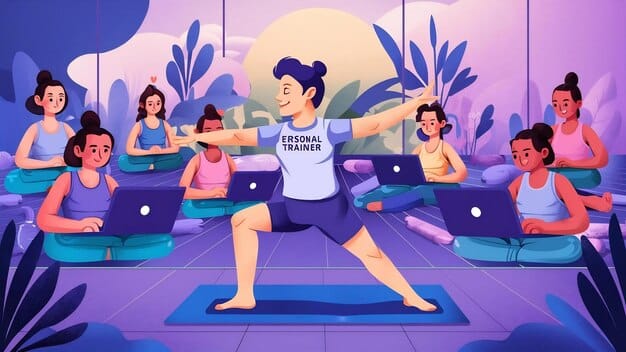US Work-Life Balance: Culture, Challenges, and Evolution

The US approach to work-life balance is largely shaped by a cultural emphasis on productivity and individualism, often creating challenges in achieving equilibrium, yet
it continues to evolve with growing awareness and initiatives aimed at fostering healthier workplace norms.
Delving into the complex interplay between professional life and personal well-being reveals a unique cultural landscape within the US. Understanding the US Approach to Work-Life Balance: A Cultural Perspective provides insight into the values and dynamics that shape this often-debated concept, inviting readers to explore its nuances and implications.
The Roots of the US Work Ethic: A Historical Context
To truly grasp the current state of work-life balance in the US, it is essential to consider the historical underpinnings of its work ethic. From its Puritanical origins to the industrial boom, American society has long cultivated a narrative that intertwines hard work with personal virtue and economic success. This deep-seated belief system has profoundly influenced societal expectations regarding labor and achievement, often prioritizing professional advancement above other aspects of life.
Puritanical Influences and Individualism
The early American settlers, particularly the Puritans, brought with them a strong work ethic, viewing hard labor as a moral duty and a path to salvation. This ethos was not merely about survival; it was imbued with spiritual significance, fostering a culture where diligence and productivity were highly esteemed. This historical lineage laid the groundwork for an individualistic society where self-reliance and the pursuit of personal success became paramount.
- Early American Values: Emphasis on self-sufficiency and moral rectitude through labor.
- Industrial Revolution Impact: Shift to factory work, demanding long hours and strict schedules.
- Post-War Prosperity: Association of hard work with economic stability and upward mobility.
- Competitive Spirit: A cultural drive for ambition and outperforming others in professional spheres.
The subsequent waves of immigration and industrialization further cemented this idea. As the nation grew, the entrepreneurial spirit thrived, reinforcing the notion that anyone could achieve success through sheer effort. This narrative, while inspiring, also implicitly suggested that personal sacrifices were necessary, blurring the lines between work and personal life.
This historical context explains why concepts like “pulling yourself up by your bootstraps” resonate so deeply within American culture. The inherent belief is that success is attainable through individual effort, and leisure, while valued, often takes a backseat to professional striving. Understanding this foundational perspective is crucial for appreciating the unique challenges and opportunities that define work-life balance in the US today.
Defining Work-Life Balance in the American Context
The term “work-life balance” itself is often interpreted differently within the American cultural framework compared to other nations. While globally it often implies an equal distribution of time and energy between professional and personal spheres, in the US, it frequently leans more towards work-life integration or even a pursuit of “work-life blend.” This distinction highlights the unique pressures and ambitions that define the American experience.
Work-Life Integration vs. Balance
Many Americans do not seek a strict separation but rather a way to weave their professional lives seamlessly into their personal ones. This can manifest in checking emails during family dinners or taking work calls on weekends, driven by a desire to remain productive and responsive. The lines blur, not necessarily out of compulsion, but often out of a perceived necessity for career progression and a continuous connection to the professional world.
- Constant Connectivity: The expectation to be reachable outside traditional work hours.
- Performance-Driven Culture: A focus on output and results, often irrespective of hours worked.
- Career Advancement: The belief that long hours and dedication are prerequisites for promotion.
- Entrepreneurial Spirit: Many individuals view their work as an extension of their identity.
The cultural narrative often praises those who are always “on,” equating constant availability with dedication and ambition. This can create a subtle pressure to mimic such behavior, even if it compromises personal well-being. The emphasis is less on time spent away from work and more on the flexibility to manage personal obligations amidst a demanding professional schedule.
This view of work-life balance is a direct reflection of the American aspiration for success and self-improvement. It suggests that individuals are constantly striving, and work is a significant part of that journey. Therefore, “balance” is not about a rigid 50/50 split but about finding a sustainable rhythm that allows for both professional achievement and personal fulfillment, however unconventional that rhythm may appear to outsiders.

Challenges and Realities: The American Worker’s Perspective
Despite growing discourse around improved well-being, the reality for many American workers remains challenging. Long working hours, limited paid time off, and the omnipresent pressure to excel contribute to a demanding professional landscape. These factors collectively impact mental health, family dynamics, and overall quality of life, creating a distinct set of obstacles for those seeking better equilibrium.
Limited Paid Time Off and Unpaid Leave
Unlike many developed nations, the US is one of the few without a federal mandate for paid parental leave or a minimum number of paid vacation days. This places a significant burden on employees, who often face difficult choices between taking time for personal emergencies or family needs and maintaining their income and job security. The absence of comprehensive national policies accentuates the challenges of balancing life’s demands with professional responsibilities.
The culture of “presenteeism,” where employees feel compelled to be physically present at work even when ill or simply to demonstrate commitment, further exacerbates this issue. This can lead to burnout and reduced productivity in the long run. The competitive nature of the job market also contributes, as individuals may fear that taking time off could be perceived as a lack of dedication, potentially hindering career progress.
These realities highlight a significant divergence from work-life norms prevalent in many European countries, where extensive leave entitlements are standard. The US approach necessitates a more individualistic strategy for managing personal life, often relying on employer-provided benefits that vary widely or personal financial planning to cover periods of absence. This can create a significant disparity in experiences across different sectors and income brackets.
Furthermore, the expectation of being constantly available, often facilitated by technology, blurs the lines between work and personal time. Smartphones and laptops enable remote work but can also extend the workday indefinitely. This “always-on” culture contributes to stress and makes it difficult for individuals to truly disengage and recharge, impacting sleep, mental health, and relationships.
The Evolution Towards Flexibility and Mindfulness
While the ingrained work ethic persists, there is a discernable shift occurring within American culture regarding work-life balance. A growing awareness of burnout, mental health, and the importance of personal well-being is driving change. Companies are increasingly exploring flexible work arrangements, and individuals are redefining their personal boundaries, signaling a potential new era for the US workforce.
The Rise of Remote Work and Hybrid Models
The COVID-19 pandemic significantly accelerated the adoption of remote and hybrid work models, forcing many organizations to rethink traditional office-centric structures. This shift demonstrated the feasibility and benefits of location-independent work, offering greater flexibility for employees to manage personal and professional demands. While not without its challenges, remote work has opened new avenues for balancing life outside the office.
- Increased Autonomy: Employees gaining more control over their schedules and work environments.
- Reduced Commute Stress: Saving time and energy that can be reallocated to personal activities.
- Geographic Flexibility: Opportunities to live further from urban centers, improving quality of life.
- Focus on Outcomes: A growing emphasis on results rather than mere hours logged.
Alongside structural changes, there’s a burgeoning movement towards mindfulness and self-care. Employers and employees alike are beginning to recognize that sustained productivity is intrinsically linked to well-being. Workshops on stress management, access to mental health resources, and promotions of healthier lifestyles are becoming more common in progressive workplaces.
This evolving landscape suggests that while the core American values of hard work and ambition remain, there is a greater willingness to adapt these values to modern realities. The conversation is shifting from simply working harder to working smarter and more sustainably. Individuals are also empowered to negotiate for more flexible terms, contributing to a more balanced approach to professional life.
Policy and Corporate Initiatives Shaping the Landscape
Beyond individual efforts, a combination of evolving public policy discussions and progressive corporate initiatives is playing a crucial role in redefining work-life balance in the US. While comprehensive federal mandates are still limited, various states, cities, and forward-thinking companies are leading the charge, implementing changes that could set new precedents.
State and Local Efforts for Paid Leave
In the absence of a federal paid leave policy, several states and municipalities have taken the initiative to enact their own paid family and medical leave laws. These localized efforts aim to provide greater financial security and flexibility for workers needing time off for childbirth, illness, or caring for family members. Such policies represent a significant step towards a more robust safety net for American workers, reducing the unique pressures faced by those in states without similar protections.
- California’s Paid Family Leave: One of the first states to implement comprehensive paid leave.
- New York Paid Family Leave: Provides wage replacement for bonding with a new child or caring for a sick family member.
- Oregon Paid Family and Medical Leave: A modern system offering broader coverage.
- City-Level Mandates: Cities like San Francisco and Seattle implement local paid leave ordinances.
Concurrently, a growing number of corporations are proactively offering enhanced benefits, recognizing that a better work-life balance contributes to employee satisfaction, retention, and ultimately, productivity. These companies often go beyond legal requirements, providing extended parental leave, unlimited paid time off (PTO), and comprehensive wellness programs. These initiatives often stem from a desire to attract top talent and cultivate a positive organizational culture.
The increasing focus on Corporate Social Responsibility (CSR) and Environmental, Social, and Governance (ESG) criteria also plays a role, pushing companies to consider employee well-being as a key performance indicator. While these progressive policies are not yet universal, they signify a gradual but meaningful shift in how work and personal life are viewed and managed within the American corporate environment.

Cultural Nuances and Societal Expectations
The discussion around work-life balance in the US cannot be separated from its unique cultural nuances and societal expectations. These often unspoken rules and collective attitudes shape individual choices and organizational behaviors, influencing how work is prioritized and how personal time is perceived.
The “Hustle Culture” Phenomenon
A prevalent aspect of contemporary American culture is the “hustle culture,” which glorifies relentless work, side gigs, and constant self-improvement tied to professional output. This mindset, often propagated through social media and entrepreneurial narratives, encourages individuals to monetize their passions and constantly optimize their time, blurring the lines further between work and leisure. While it can empower some, it also creates an unspoken pressure to always be productive, fostering a fear of “missing out” on opportunities if one is not constantly working or learning.
This cultural emphasis on “doing more” can lead to feelings of guilt or inadequacy for those who prioritize downtime or seek a more traditional work-life separation. It also contributes to a comparison culture, where individuals measure their success and dedication against those who appear to be constantly striving. The pursuit of “balance” then becomes less about rest and more about optimizing time for maximum efficiency across all areas of life, from career to fitness to personal development.
Furthermore, American society often places significant value on career identity. For many, what they “do” defines a large part of “who they are,” leading to a strong psychological attachment to their professional roles. This can make it difficult to disengage from work, as it feels like disengaging from a core part of one’s identity. The concept of “retirement” also holds unique cultural significance, often viewed as the ultimate reward for a lifetime of hard work, rather than a gradual transition to reduced hours or a different lifestyle.
Understanding these deep-seated cultural drivers is essential for appreciating why the US approach to work-life balance is distinct. It reflects a society that values ambition, individuality, and a relentless pursuit of economic and professional success, even as it grapples with the human cost of such a demanding ethos.
The Future of Work-Life Balance in the US
The path forward for work-life balance in the US is likely to be one of continuous adaptation and negotiation. As societal values evolve and the workforce becomes more diverse, the pressures and priorities surrounding work will inevitably shift. The future points towards a more nuanced understanding, driven by individual needs, technological advancements, and a growing recognition of the interconnectedness of well-being and productivity.
Evolving Employee Expectations and Employer Responses
Increasingly, new generations entering the workforce are prioritizing flexibility, purpose, and well-being alongside traditional career advancement. This demographic shift is pushing employers to offer more comprehensive work-life benefits and cultivate cultures that support mental health and personal development. Companies that fail to adapt risk losing out on top talent and facing higher rates of burnout and attrition.
The integration of artificial intelligence and automation may also play a crucial role. By streamlining routine tasks, technology could potentially free up human workers to focus on more creative, strategic, and less time-consuming activities, thereby reducing overall work hours or intensities. However, this future also presents challenges, such as the need for upskilling and adapting to new forms of work.
Ultimately, the discussion is moving beyond a simplistic “balance” to a more holistic view of well-being that encompasses financial stability, mental health, physical health, and social connections. The US approach, while historically leaning towards high productivity, is gradually acknowledging that a truly thriving workforce requires a thoughtful integration of life and work. The ongoing dialogue, punctuated by policy changes and corporate innovations, suggests a future where adaptability and individual empowerment will be key to achieving sustainable work-life harmony.
| Key Aspect | Brief Description |
|---|---|
| 🏛️ Cultural Roots | Driven by Puritan work ethic and strong individualism valuing productivity and success. |
| ⚖️ Balance Concept | Often seen as “work-life integration” or “blend” rather than strict separation. |
| 🚧 Core Challenges | Long hours, limited mandated paid time off, and the “always-on” culture. |
| 🚀 Future Outlook | Shifting towards flexibility, mindfulness, and valuing holistic employee well-being. |
Frequently Asked Questions About US Work-Life Balance
▼
The challenge stems from a deeply ingrained cultural work ethic emphasizing productivity and success, often leading to long working hours and an “always-on” mentality. Unlike many other developed nations, the US lacks federal mandates for paid time off, placing more burden on individual employees to manage their personal time.
▼
“Work-life balance” often implies a clear separation between professional and personal life, seeking equal time distribution. In the US, “work-life integration” suggests a more fluid blending of these aspects, where work can seamlessly weave into personal time, often driven by constant connectivity and a desire for continued productivity and ambition.
▼
Remote work, especially accelerated by the pandemic, has significantly expanded flexibility, allowing employees more control over their schedules and reducing commute stress. While it can blur boundaries, it also offers opportunities for better personal time management and has driven a shift towards results-oriented work rather than just hours logged.
▼
While no federal paid leave mandate exists, several US states and cities have enacted their own paid family and medical leave laws. Additionally, a growing number of progressive companies are implementing enhanced benefits like extended parental leave, unlimited PTO, and comprehensive wellness programs to attract and retain talent.
▼
The “hustle culture” glorifies constant work and productivity, often encouraging side gigs and monetizing passions. This creates pressure to always be “on” and can lead to guilt about downtime, making it challenging for individuals to disengage from work. It perpetuates a cycle where leisure is often seen as an opportunity for more “productive” activities.
Conclusion
The dialogue surrounding work-life balance in the US is a dynamic reflection of its core cultural values and evolving societal norms. While historically rooted in a strong work ethic and individualism, there’s a tangible shift towards greater flexibility, mindfulness, and a holistic view of well-being. Understanding this intricate interplay is key to navigating the unique American approach, where the pursuit of success is gradually being re-evaluated through the lens of sustainability and personal fulfillment for a healthier, more productive future workforce.





